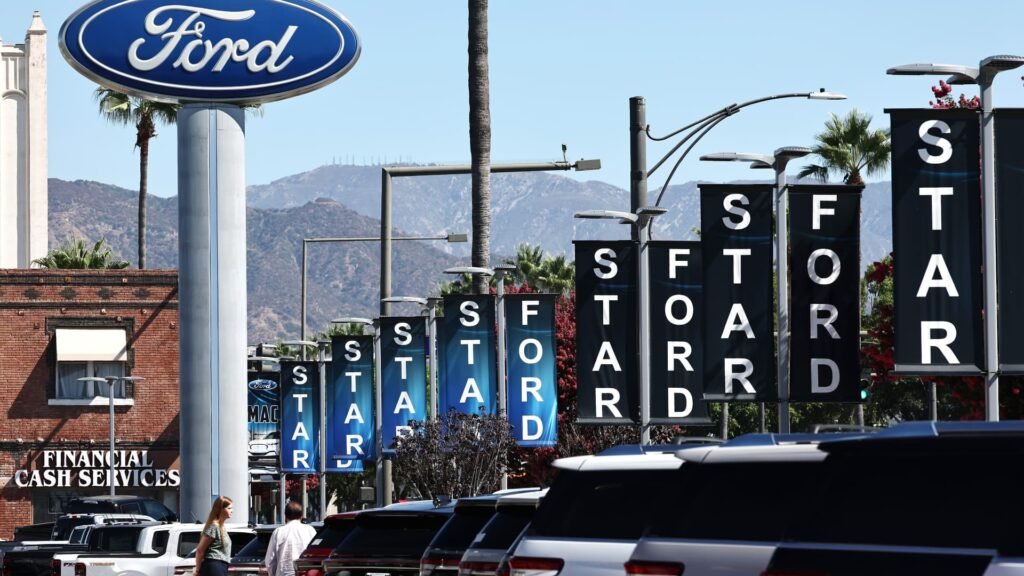Ford and Lincoln vehicles on display for sale at a Ford dealership on August 21, 2024 in Glendale, California.
Tama Mario | Getty Images
Detroit — ford motor It slightly beat Wall Street’s third-quarter expectations, leading to the lower end of its previously announced 2024 earnings forecast.
The Detroit automaker said Monday it expects adjusted earnings before interest and taxes (EBIT) to be about $10 billion. It was previously expected to be between $10 billion and $12 billion. The company maintained its forecast for adjusted free cash flow of $7.5 billion to $8.5 billion.
In the lead-up to Monday’s earnings release, multiple Wall Street analysts said slowing demand, rising vehicle inventory levels and concerns about whether Ford will be able to meet the $2 billion in cost savings announced this year were concerned that they might have to revise their forecasts downward.
“We remain focused on cost and quality, but that is holding back our progress and we are not seeing significant gains,” John Lawler, Ford’s chief financial officer and vice chairman, said in a Monday press conference. “This indicates the possibility of fluctuations.”
Lawler said Ford achieved $2 billion in materials, transportation and manufacturing costs, but inflation and rising warranty costs hindered these improvements, limiting the company from having a “record year.” He said that
Here’s how the company performed in the third quarter compared to average estimates compiled by LSEG:
- Earnings per share: Adjusted 49 cents, expected 47 cents.
- Automotive revenue: $43.07 billion vs. expected $41.88 billion
The company’s stock closed 2.7% higher at $11.37 on Monday, before falling about 5% in after-hours trading.
The automaker was under pressure after a disappointing second quarter that missed Wall Street’s earnings expectations due to unexpected warranty costs.
Lawler said the company’s warranty costs, which rose $800 million in the second quarter from a year earlier, were slightly lower in the third quarter than a year ago.
“It’s an improvement, but not as great as we would like,” Lawlor said, declining to disclose total costs over the period.
Ford’s third-quarter results were driven by its Pro commercial and fleet businesses and its legacy business, known as Ford Blue. Blue reported adjusted earnings of $1.63 billion, while Pro reported $1.81 billion.
Lawlor said Ford Pro and Blue’s operations have been and will likely continue to be affected by issues with some of their suppliers, in part due to Hurricane Helen in late September.
Ford’s Model E electric vehicle unit posted a loss of $1.22 billion in the third quarter, down from a year-ago loss primarily due to lower unit sales and cost cuts. .
Ford CEO Jim Farley told investors Monday that the company continues to believe in its EV strategy. However, automakers have withdrawn much of their investment in vehicles to focus on hybrid models.
Ford’s third-quarter net income was $896 million, or 22 cents per share. Adjusted EBIT increased approximately 16% year over year to $2.55 billion. For the third quarter of 2023, Ford reported auto revenue of $41.18 billion, net income of $1.17 billion (30 cents per share), and adjusted earnings before interest and taxes of $2.2 billion (per share). 39 cents).
Ford’s overall revenue, which includes its financial operations, rose about 5% from a year earlier to $46.2 billion in the third quarter. This marks the company’s 10th consecutive quarter of year-over-year revenue growth.
Farley noted that the company’s operations in China, where traditional automakers are increasingly struggling, contributed more than $600 million to the company’s EBIT. This includes Ford’s plans to increase car exports from the country.
Mr. Farley also noted the company’s rising new vehicle inventory levels. As of the end of the third quarter, Ford had 91 days’ worth of total inventory, including its own vehicles, and 68 days’ worth of supplies for dealers, causing concern among investors.
He said the configuration and pricing of these vehicles is “very good” and the company is holding back some inventory to support the vehicle changeover in early 2025.




